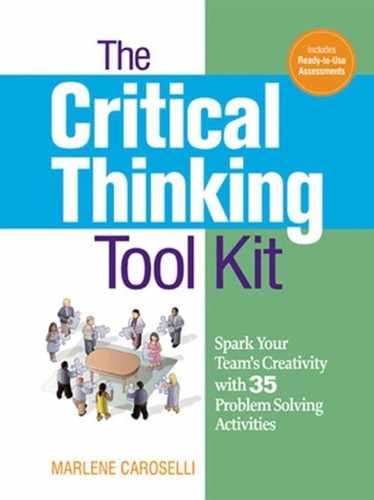#21: A Kin to Kinesthesia
Overview: |
Participants will collaborate to express work-related ideas in kinesthetic terms. |
Objective: |
To stimulate participants to consider alternative modes of expression. |
Supplies: |
• Transparency #21-1 • Overhead projector • Flipchart |
Time: |
About 15 minutes |
Advance |
Download Transparency #21-1. If possible, arrange seating so groups of four or five can work together. |
Participants/ |
No matter the size of the group, this exercise will stimulate creative views on common organizational issues. Hence, it can be used at any time during the training session—as an opening, closing, or in-the-middle way of synthesizing the learning that has occurred. |
Introduction to Concept:
“Synesthesia” is a cognitive power enjoyed by a rare few. The word refers to the natural and involuntary ability to simultaneously perceive stimuli with the senses usually employed and the senses not usually employed. There are people, for example, who not only see but “hear” color as it comes into their range of vision. There are those who can touch a keyboard and as they do, the “taste” of the keyboard pops into their minds automatically. A related term is “kinesthesia,” which refers to the expression of an idea in atypical sensory terms. To illustrate, you cannot literally feel negative interpersonal relationships. However, if you could, would they feel to the touch like velvet or like sandpaper? If you could hear a motivated group of employees, would they sound like popcorn popping, or a pellet dropping through sludge? Kinesthesia is not only a creative means of articulating a concept, it is often a useful means. In terms of thinking skills, it ranks among the highest-order abilities, according to the taxonomy established by Dr. Benjamin Bloom: it asks us to make relationships between disparate pieces of knowledge.
Procedure:
1. Begin by recording on the flipchart either key issues facing the participants as employees or else key words they would associate with the training being conducted. Record at least 20 terms.
2. Divide the group into teams of four or five. Explain the next steps as they look at the transparency. (Show Transparency #21-1 now.)
Once your team has selected one issue or key concept from the list on the flipchart, you will work to express that idea in kinesthetic terms.
Next, take a few minutes to list as many related terms as you can. For “popcorn,” as an illustration, you might have added “oil,” “butter,” “salt,” “Orville Reddenbacher,” “kernel,” “microwave,” “movie theater,” and so on. You should have at least ten additional words to work with.
Finally, your team will prepare a statement of one paragraph in length using both kinesthetic descriptions and the related words; it should explore the issue you have chosen and suggest a way to improve upon the existing reality or a recommended course of action.
Here’s an example for you:
We hear motivation popping like popcorn all over our office. Kernels of ideas are exploding all the time. Management, of course, can add “butter” and “salt” in the form of equipment and support. But as you microwavers know, popcorn can easily burn and employees can burn out if there is no follow-through on the ideas bursting out of their mental membranes.
3. Allow about ten minutes for the groups to prepare their statements.
4. Call on a spokesperson from each team to share the kinesthetic creations with the class as a whole.
Extending the Activity:
1. Collect magazine advertisements (such as the one for luncheon meats that shows a bowling ball hitting pins) or other kinesthetic examples, such as the title of the Jack Canfield–Mark Victor Hansen book, Chicken Soup for the Soul. Share these with the group as examples of how powerful kinesthesia can be as an expressive force.
2. Have participants identify one problem they feel they most need help with, such as stress reduction. Then begin a collection of ideas for converting distress to eustress. Work with the group to find a fitting kinesthetic title for the collection. (“Herbal Tea for the Employee’s Soul” is one example.)
3. Ask participants to list ten to twenty workplace characteristics. Then, in pairs, they will draw quick sketches in order to complete this kinesthetic prompt:
This is what __________ does for/to __________.
To illustrate: The sketch could be a jackhammer breaking up concrete. The sentence could read, “This is what recognition does to employees’ gripes.”
1. The ever-popular Dilbert cartoon series was created around working conditions employees felt were worth writing about. Workers e-mailed their gripes to Scott Adams and the empire-builder struck back in the most charmingly comedic way possible. Somewhere in every organization is an individual with artistic ability. If participants can funnel their workplace issues/concerns/problems to him or her, the artist may be able to produce a comparable Dilbert series, with a kinesthetic title for the series; e.g., “Hot Fudge for Monday – Friday.”
2. Recommend that employees keep journals (at home) of workplace anecdotes or occurrences. After the description of each, they should give it a “kinesthetic” title.
3. The next time the organization’s leader makes a major address (or writes in the annual report or company newsletter), participants can be on the lookout for kinesthetic references and can discuss them with one another afterwards.
Questions for Further Consideration:
1. Why do you think the Chicken Soup for the Soul title has so captivated book-buyers?
2. As you think back over things you have done, seen, read, heard in your lifetime, what unusual expressions come to mind? (Albert Einstein, for example, once explained Euclidian geometry with reference to a slab of marble.)
3. How can we expand our analytic power to go beyond the literal?
4. Who in your workplace do you think would most appreciate your occasional description of a workplace issue in kinesthetic terms?
5. What might prevent you from using such a description with this person?
